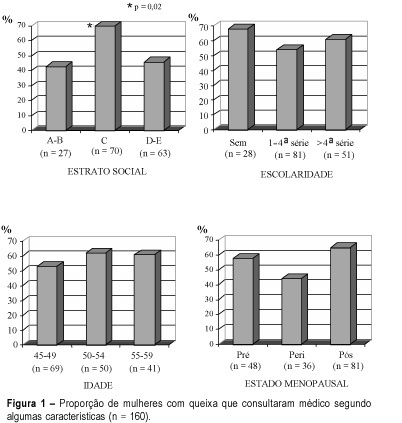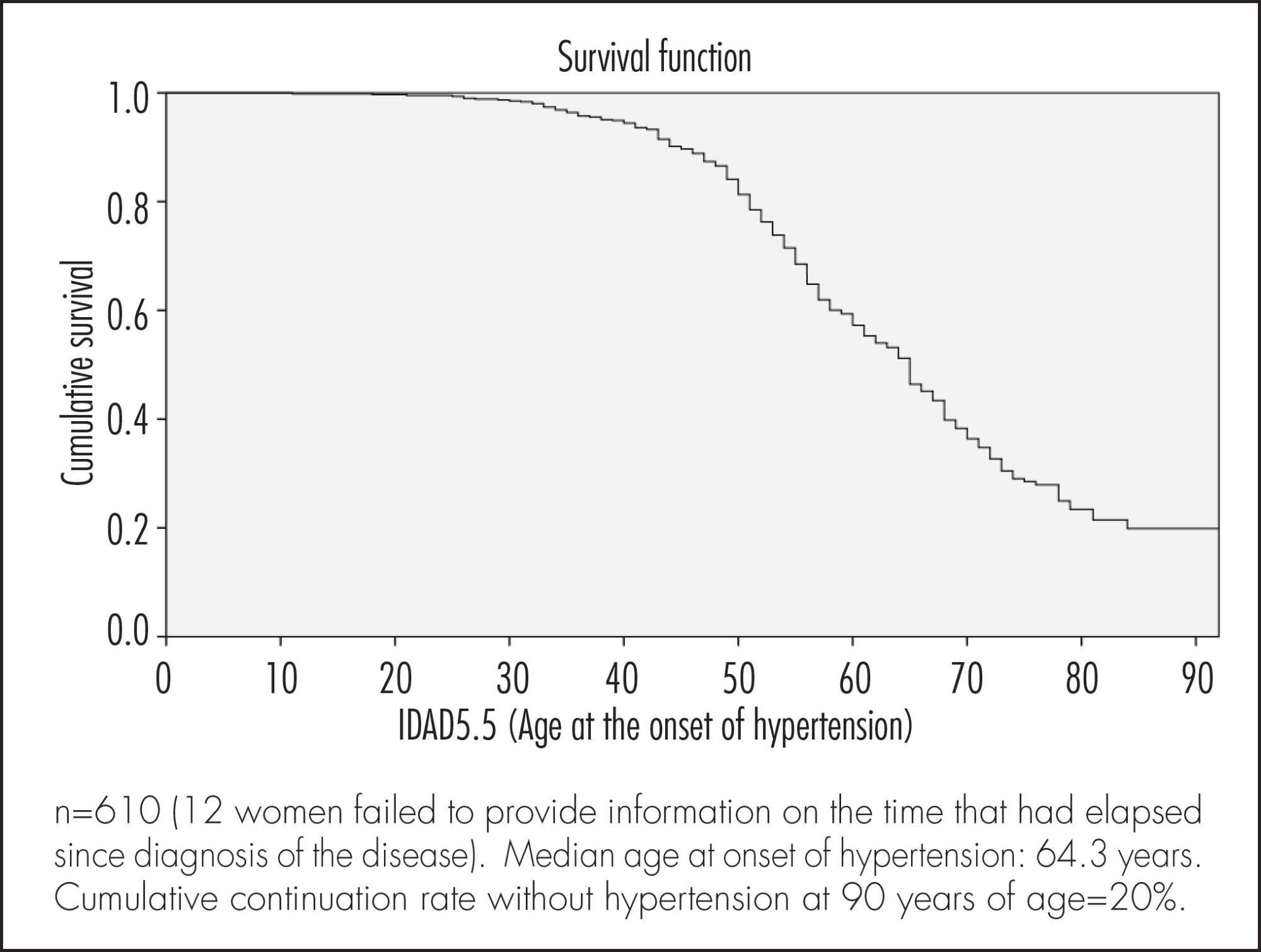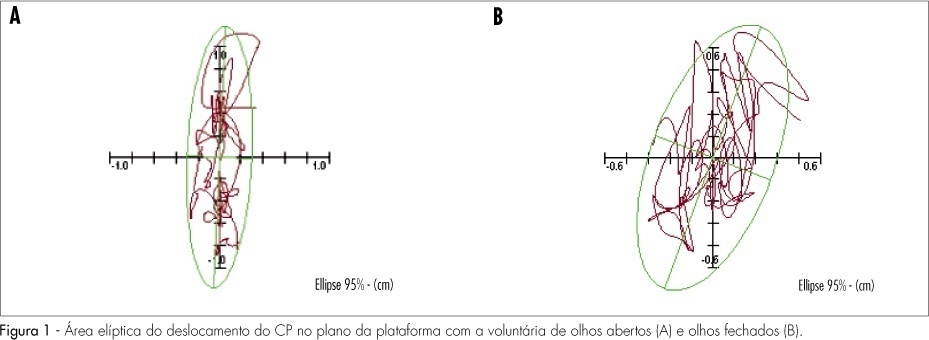You searched for:"Aarão Mendes Pinto-Neto"
We found (27) results for your search.Summary
Revista Brasileira de Ginecologia e Obstetrícia. 2001;23(7):439-443
DOI 10.1590/S0100-72032001000700005
Purpose: to evaluate the percentage of 45- to 60-year-old women complaining of urinary incontinence, who look for medical treatment, and the factors possibly associated with the decision of visiting the doctor and the reasons for not doing so. Methods: a secondary analysis of a population-based survey on climacterium and menopause in women living in the city of Campinas, São Paulo state, was carried out through a descriptive, exploratory and cross-sectional population study. A total of 456 women between 45 and 60 years of age were selected through a sampling process. The age at menopause and its associated factors were evaluated, as well as the prevalence of climacteric symptoms, the use of medical care, self-perception of the health status, and the sociocultural, sociodemographic and socioeconomic characteristics. Urinary incontinence complaint and the search for medical help due to the presence of symptoms were explored. The data were collected through home interviews, using a structured and pretested questionnaire provided by the International Health Foundation/International Menopause Society and by the North American Menopause Society, and adapted by the authors. The statistical analysis was performed using Fisher's exact test. Results: thirty-five percent of the interviewees reported constant or intermittent stress incontinence, although only 59% of the patients with the complaint sought medical help. Conclusion: the majority of the women presenting urinary incontinence do not complain to the doctor if they are not questioned objectively.

Summary
Revista Brasileira de Ginecologia e Obstetrícia. 2014;36(10):467-472
DOI 10.1590/SO100-720320140005094
To evaluate factors associated with hypertension in Brazilian women of 50 years of age or more.
A cross-sectional population based study using self-reports. A total of 622 women were included. The association between sociodemographic, clinical and behavioral factors and the woman's age at the onset of hypertension was evaluated. Data were analyzed according to cumulative continuation rates without hypertension, using the life-table method and considering annual intervals. Next, a Cox multiple regression analysis model was adjusted to analyze the occurrence rates of hypertension according to various predictor variables. Significance level was pre-established at 5% (95% confidence level) and the sampling plan (primary sampling unit) was taken into consideration.
Median age at onset of hypertension was 64.3 years. Cumulative continuation rate without hypertension at 90 years was 20%. Higher body mass index (BMI) at 20–30 years of age was associated with a higher cumulative occurrence rate of hypertension over time (coefficient=0.078; p<0.001). Being white was associated with a lower cumulative occurrence rate of hypertension over time (coefficient= -0.439; p=0.003), while smoking >15 cigarettes/day was associated with a higher rate over time (coefficient=0.485; p=0.004).
The results of the present study highlight the importance of weight control in young adulthood and of avoiding smoking in preventing hypertension in women aged ≥50 years.

Summary
Revista Brasileira de Ginecologia e Obstetrícia. 2000;22(8):475-479
DOI 10.1590/S0100-72032000000800002
Purpose: to evaluate the bone mineral density of postmenopausal women with previous hysterectomy and with bilateral ovarian conservation compared to a group of nonhysterectomized naturally menopausal women. Methods: this is a cross-sectional study of bone densitometry (Lunar DPX) in 30 menopausal women hysterectomized when in the premenopause compared with 102 naturally postmenopausal women. Results: the mean age, body mass index, color of the skin, smoking habits, educational level, menarche, parity and previous tubal ligation were similar in the studied groups. Bone mineral density average and the T-score of the three femural sites analyzed by the Bonferroni test did not show significant differences. The bone mineral density average and the T-score of the lumbar spine were analyzed by the Student t test and did not show statistical differences. Conclusion: these findings suggest that premenopausal hysterectomy with bilateral ovarian conservation does not cause an additional reduction in bone mineral content when evaluated in the postmenopause.
Summary
Revista Brasileira de Ginecologia e Obstetrícia. 2009;31(10):496-502
DOI 10.1590/S0100-72032009001000005
PURPOSE: to evaluate the rate of fall and its association with stabilometric parameters in postmenopause women, with or without osteoporosis. METHODS: transversal cohort study including 266 over 60-year-old women with and without osteoporosis, with at least 12 months of amenorrhea. The women were interviewed about the occurrence of falls in the previous 12 months, and about clinical and sociodemographic information. The osteoporosis diagnosis was done through bone densitometry and the postural stability evaluated through a stabilometric platform. For statistical analysis, mean, standard deviation, percentage, Mann-Whitney test, χ2 and Odds Ratio, and Spearman's correlation coefficient have been calculated. RESULTS: women with osteoporosis presented lower body mass index (BMI), lower schooling, shorter hormonal therapy and sooner menopause onset. The rate of fall was significantly higher in the group of women with osteoporosis (51.1%) (p<0.01), that presented an adjusted risk of 1.9 (1.3 to 3.4) times higher of falls and 3.2 (1.2 a 8.2) times higher of recurrent falls than the group without osteoporosis. Women with osteoporosis presented higher amplitude of Y axis oscillation in the open-eye test, than women without osteoporosis. The adjusted correlation analysis between stabilometric parameters and falls has not shown any significant correlation. CONCLUSIONS: women with post-menopausal osteoporosis present higher rate of falls and higher risk of recurrent falls, as compared with women without osteoporosis.

Summary
Revista Brasileira de Ginecologia e Obstetrícia. 2013;35(11):497-502
DOI 10.1590/S0100-72032013001100004
PURPOSE: To analyze the prevalence of and factors associated with fragility fractures in Brazilian women aged 50 years and older. METHODS: This cross-sectional population survey, conducted between May 10 and October 31, 2011, included 622 women aged >50 years living in a city in southeastern Brazil. A questionnaire was administered to each woman by a trained interviewer. The associations between the occurrence of a fragility fracture after age 50 years and sociodemographic data, health-related habits and problems, self-perception of health and evaluation of functional capacity were determined by the χ2 test and Poisson regression using the backward selection criteria. RESULTS: The mean age of the 622 women was 64.1 years. The prevalence of fragility fractures was 10.8%, with 1.8% reporting hip fracture. In the final statistical model, a longer time since menopause (PR 1.03; 95%CI 1.01-1.05; p<0.01) and osteoporosis (PR 1.97; 95%CI 1.27-3.08; p<0.01) were associated with a higher prevalence of fractures. CONCLUSIONS: These findings may provide a better understanding of the risk factors associated with fragility fractures in Brazilian women and emphasize the importance of performing bone densitometry.
Summary
Revista Brasileira de Ginecologia e Obstetrícia. 2003;25(7):507-512
DOI 10.1590/S0100-72032003000700007
PURPOSE: to evaluate the prevalence of osteoporosis in climacteric women and analyze the influence of general and reproductive risk factors on bone mineral density. METHODS: a cross-sectional study with the evaluation of the 473 hospital records of climacteric women followed up at the Menopause Outpatient Facility of CAISM/Unicamp, between 03/28/2000 and 04/17/2001. These women were at least 12 months in amenorrhea and presented the results of a bone densitometry study performed at the Nuclear Medicine Department of HC/Unicamp. The following variables were evaluated: age, color, body mass index, level of education, smoking, use of medication, age at menopause, parity, use and length of hormone replacement therapy and its effect on bone mineral density. Statistical analyses were performed using logistic regression ajusted by age and hormone replacement therapy use. RESULTS: the mean age of the studied women was 53.9 years (± 7.1 SD) with mean age at menopause being 45.9 years (± 6.9 SD). Osteoporosis occurred in 14.7% and osteopenia in 38% of the cases in the lumbar vertebrae (L2-L4 interspace) and in 3.8 and 32.7% in the femur, respectively. Logistic regression adjusted to age and hormone therapy showed an association between the following variables: level of education, age at menopause and body mass index. CONCLUSION: there was a high prevalence of osteoporosis and osteopenia in the studied population. Advanced age, lower level of education, late menarche, early menopause and lower body mass index were identified as risk factors for developing decreased bone mass in the studied population.
Summary
Summary
Revista Brasileira de Ginecologia e Obstetrícia. 2009;31(2):61-67
DOI 10.1590/S0100-72032009000200003
PURPOSE: to evaluate the quality of life and sexuality features of women with breast cancer, according to the type of surgery they underwent and their sociodemographic characteristics. METHODS: transversal study with 110 women treated for breast cancer, for at least one year in the Centro de Atenção Integral à Saúde da Mulher of UNICAMP. The quality of life was assessed by the WHOQOL-bref questionnaire, and the issues on sexuality, by a specific questionnaire in which Cronbach's Alpha coefficient was used to validate the concordance of responses (alpha=0.72) and the technique of factor analysis, with the criterion of self value and variance maximum rotation, resulting in two components: intrinsic or intimacy ( how the woman sees herself sexually) and extrinsic or attractiveness (how the woman believes the others see her sexually). Sociodemographic variables have been assessed according to the WHO questionnaire, and the sexuality components, through the Kruskal-Wallis followed by the Mann-Whitney's test and Spearman correlation test. RESULTS: age, schooling, type of surgery and lapse of time from the surgery did not influence the quality of life concerning physical, environmental, and psychological aspects, as well as the social relationships. Women with a stable marital relationship got higher scores in the psychological area (p=0.04) and in the area of social relationships (p=0.02). Higher socioeconomic level influenced the quality of life concerning physical appearance (p=0.01) and environment (p=0.002). Regarding the sexuality, age had influence in the extrinsic component (p=0.0158). Women with a stable marital relationship had higher scores of quality of life in both components of sexuality. Higher schooling influenced in a positive way the intrinsic factor. Women submitted to quadrantectomy or mastectomy with immediate breast reconstruction showed higher scores relating to attractiveness in comparison to mastectomized women without reconstruction. CONCLUSIONS: better socioeconomic level and better schooling, stable marital relationship and surgery with breast conservation are linked to better rates of quality of life, including sexuality.